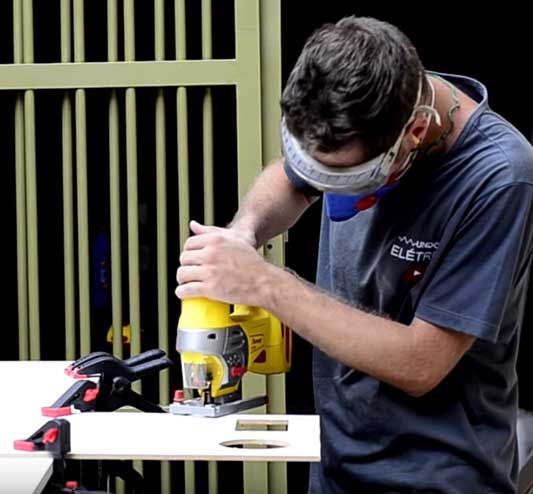Jigsaw Safety Toolbox Talk
Jigsaw Safety
While many types of portable saws rip and tear through materials very quickly, a hand-held jigsaw is designed for more intricate or precise cutting jobs. However, you can still easily lose a piece of a finger or suffer some other debilitating injury when using a jigsaw. These risks can be minimized by safe operating procedures and using proper personal protective equipment.
Training
Operators should receive training from their supervisor on each type of jigsaw they are tasked to operate. Prior to operating the equipment for the first time, the operator should review the Operator's Manual to familiarize themselves with the inspection requirements, jigsaw’s controls and operating procedures.
Preparing for safe operation
- Inspect your equipment prior to and periodically throughout jigsaw operations:
- Ensure that guards, battery pack, and cords (if applicable) are free of damages and in place.
- Make sure the cutting blade installed on your jigsaw is correct for the type of work and suitable for use on the type of materials you will be cutting.
- Check the blade to make sure it has not loosened and re-tighten as necessary.
- Make sure that the blade is sharp and there is not broken teeth, bent or broken sections, or any other damage.
- Ensure a suitable and safe work area before starting to cut.
- Make sure that the work area is free of oil and flammable liquids/gases.
- Always secure the material on a stable surface with clamps, so that it will not move around when you begin to operate the jigsaw.
- Use Personal Protective Equipment:
- Wear safety glasses, hearing protection, dust mask and safety shoes to work with a jigsaw.
- Do not wear jewelry or loose clothing and tie long hair back to avoid possible entanglement.
- Wear safety glasses, hearing protection, dust mask and safety shoes to work with a jigsaw.
Safe operating procedures
- Ensure the switch is in the “OFF” position before plugging the saw into the power or connecting the battery pack. This will avoid accidental startups.
- Remove any adjusting key or wrench before turning the power tool on.
- Check the underside of the cut area to ensure that the blade will not cause any damage and that there are no obstructions.
- Always make sure the cord is out of the cutting area (if applicable).
- Position the jigsaw’s base on the cut area but make sure the blade is not touching the cut area. Then allow the machine to reach full speed before you start cutting.
- Keep your balance and proper footing while operating the equipment.
- Always keep your fingers away from saw blades when cutting.
- Never put your hands underneath of the work surface.
- Never try to clean off the jigsaw table with your hands while the saw is running.
- Hold the jigsaw with two hands when operating it (see picture beside). Beyond helping to control the equipment, this will keep your fingers away from the moving portion of the blade that extends below the material being cut.
- Do not apply excessive force when using a jigsaw, especially when cutting curves and angles. Ensure that the blade does not twist or bind (if necessary, drill small holes).
- Periodically examine the material for splits, loose knots and nails. Ensure the material is secure and well supported.
- If the blade binds, release the switch immediately – free the blade and inspect for damage.
- Regularly clean up the waste on or around the saw blade or the work piece. (ensure that the saw is not powered during this task)
- Do not remove the saw from the work piece until the blade has come to a complete stop.
- Prior to conducting any maintenance or making an adjustment, always disconnect the plug from the power source or the battery pack from the power tool.
- Refer to the manual to make sure the correct procedure for maintenance or adjustments is completed
- To replace blades, use suitable tools (if applicable). If the jigsaw does not require tools, make sure to check the blade’s lock and unlocked position. Do not touch the blades teeth. This will avoid any injury to one’s finger(s).
- Refer to the manual to make sure the correct procedure for maintenance or adjustments is completed



